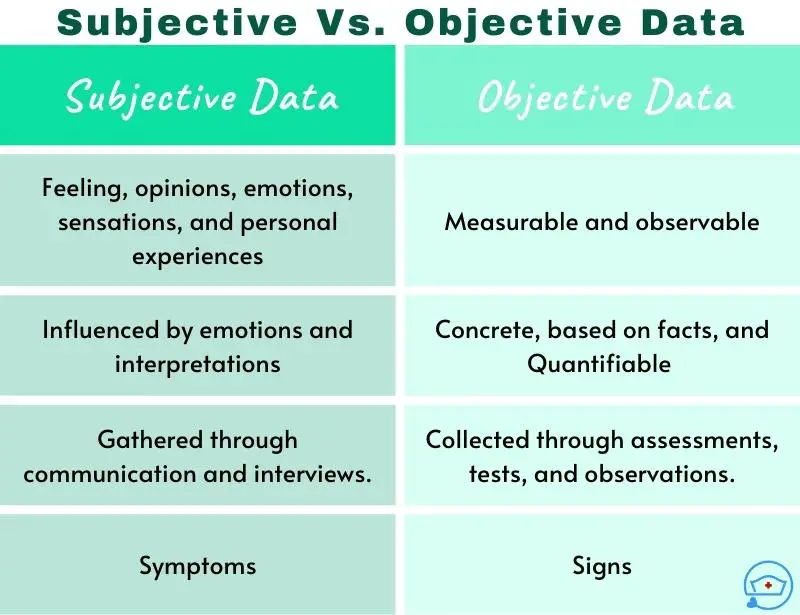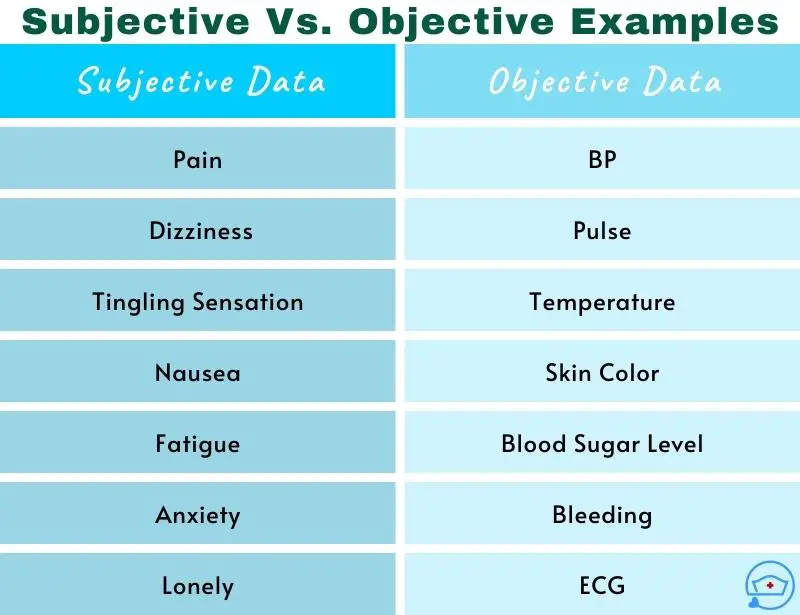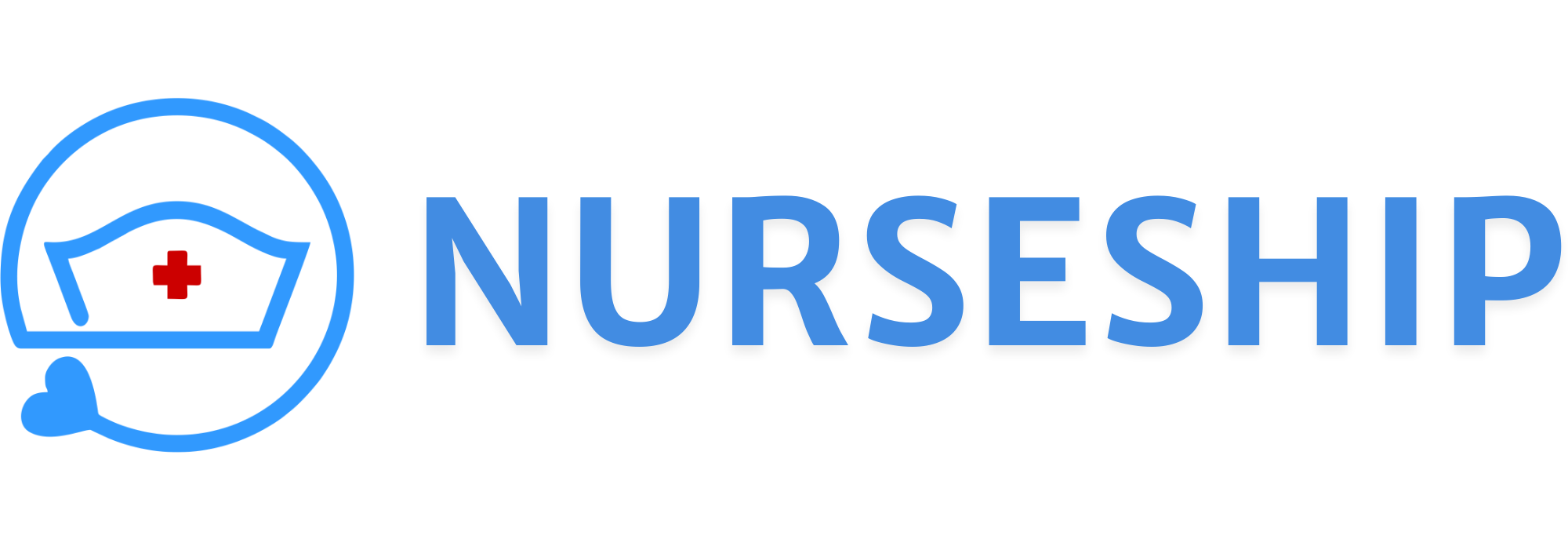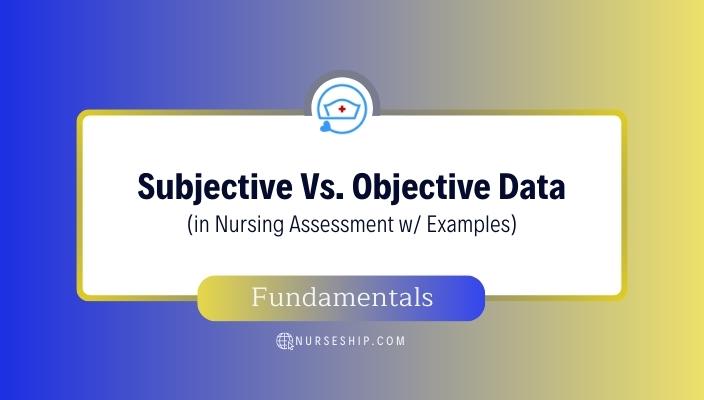Data collection is a component of the Nursing Assessment, which stands as the initial step in the nursing process.
There are two types of data collection in nursing. They are; i. subjective and ii. objective data.
Effective patient assessment and care planning are built on these two types of data.
In this article, we’ll explore the concepts of subjective vs objective data, provide real-life examples, and offer insights into their significance in clinical practice.

What is Subjective Data in Nursing Assessment?
Definition and Characteristics of Subjective Data
Subjective data in nursing refers to information obtained through patient communication, capturing their opinions, emotions, sensations, and personal experiences.
It relies on the patient’s perspective and is often influenced by their individual feelings and interpretations.
These are often referred to as symptoms.
Definition
Subjective data can be defined as information that’s unique to the patient’s personal experience and can be described by them.
| Characteristic | Description |
|---|---|
| Source | Patient’s verbal expressions, written descriptions, or reports. |
| Nature | Influenced by emotions, personal beliefs, and experiences. |
| Collection Method | Gathered through interviews, conversations, questionnaires, and patient history-taking. |
| Examples | Pain descriptions, emotional state, patient history, symptoms as described by the patient. |
What are the Examples of Subjective Data?
| Subjective Data Type | Examples |
|---|---|
| Pain Description | “I have a sharp, throbbing pain in my lower abdomen.” |
| Emotional State | “I feel anxious and worried about the upcoming procedure.” |
| Patient History | “My grandmother had diabetes and hypertension.” |
| Symptom Description | “I’ve been experiencing frequent headaches and dizziness.” |
What is Objective Data in Nursing Assessment?
Definition and Characteristics of Objective Data
Objective data in nursing refers to measurable and observable information collected through assessments, tests, and observations.
It is not influenced by personal opinions and provides a concrete, quantifiable view of the patient’s physical condition.
Definition
Objective data are concrete facts that can be observed and measured, and they are known as ‘signs’ of a disorder.
| Characteristic | Description |
|---|---|
| Source | Physical examinations, diagnostic tests, and observations. |
| Nature | Based on facts, measurable and quantifiable. |
| Collection Method | Physical assessments, laboratory tests, imaging studies, and observations. |
| Examples | Vital signs, physical examination findings, laboratory test results. |
What are the Examples of Objective Data?
| Objective Data Type | Examples |
|---|---|
| Vital Signs | Heart rate: 85 bpm, Blood pressure: 120/80 mmHg, Respiratory rate: 18 breaths per minute, Body temperature: 98.6°F (37°C). |
| Physical Examination | Skin color: Pale, Appearance: Wound with purulent discharge, Range of motion: Limited shoulder mobility. |
| Laboratory Test Results | Hemoglobin level: 12 g/dL, Glucose level: 110 mg/dL, White blood cell count: 8,000/mm³. |
Subjective Vs Objective Data in Nursing Assessment
| Aspect | Subjective Data | Objective Data |
|---|---|---|
| Source | Patient’s feelings, opinions, and experiences. | Measurable and observable information. |
| Nature | Influenced by emotions and interpretations. | Concrete, based on facts and measurements. |
| Collection Method | Gathered through communication and interviews. | Collected through assessments, tests, and observations. |
| Examples | Pain descriptions, emotional states, patient history. | Vital signs, physical exam findings, laboratory results. |

Significance of Subjective and Objective Data
Both subjective and objective data play vital roles in patient care.
Subjective data provides insight into a patient’s perspective, emotions, and experiences, enhancing holistic care.
Objective data offers concrete information for accurate diagnoses and treatment planning.
Bridging the Gap: Integrating Both Types of Data
To provide comprehensive care, nursing professionals must integrate both subjective and objective data.
Combining these two types of information allows for a holistic understanding of the patient’s health status and enables evidence-based decision-making.
| Scenario | Integration of Subjective and Objective Data |
|---|---|
| Patient Reporting Pain | The patient reports severe abdominal pain (subjective data). The nurse assesses the patient’s vital signs, palpates the abdomen, and observes facial expressions (objective data). Together, this information helps the nurse understand the pain’s severity and potential causes. |
Let’s consider a scenario involving a patient named Alex who is experiencing abdominal pain.
Scenario 2: Abdominal Pain Assessment
Alex, a 30-year-old patient, arrives at the hospital with complaints of severe abdominal pain. As a nurse, you’re tasked with assessing Alex’s condition.
Subjective Data:
Alex provides the following information during your conversation:
- “I’ve been having this sharp, stabbing pain in my lower abdomen for the past six hours.”
- “The pain started after I had a heavy meal at a restaurant.”
- “I rate the pain as 8 out of 10 on a scale of severity.”
In this scenario, the subjective data includes Alex’s personal descriptions of the pain, its onset, and its intensity.
It’s based on his feelings and experiences and cannot be measured directly.
Objective Data:
During your assessment, you gather the following objective data:
- Vital Signs: You measure Alex’s vital signs, and his heart rate is 110 beats per minute, blood pressure is 130/80 mmHg, respiratory rate is 18 breaths per minute, and body temperature is 98.6°F (37°C).
- Physical Examination: You palpate Alex’s abdomen and notice tenderness in the lower right quadrant. His skin is warm and slightly pale.
- Laboratory Tests: Blood tests show an elevated white blood cell count.
- Imaging: An abdominal ultrasound reveals inflammation in the appendix.
In this part of the scenario, the objective data includes the measurable and observable information collected during your assessment, such as vital signs, physical examination findings, laboratory test results, and imaging studies.
These objective measurements and observations help provide a more comprehensive view of Alex’s health status.
Interpreting the Data:
Combining both subjective and objective data, you can form a better understanding of Alex’s situation.
His self-reported pain description (subjective data) helps you appreciate the nature and location of the pain.
The elevated heart rate, tenderness on palpation, and abnormal laboratory results (objective data) provide additional clues that support a more informed assessment.
In conclusion, subjective data involves what the patient feels and experiences, while objective data consists of measurable and observable facts.
By integrating both types of data, healthcare providers can make accurate assessments and formulate appropriate care plans for their patients.
Scenario 3: John’s Respiratory Distress
Let’s explore another scenario that involves respiratory distress to illustrate the concepts of subjective and objective data.
Meet John, a 60-year-old man who is rushed to the emergency room due to severe shortness of breath.
Subjective Data:
As John struggles to catch his breath, he provides the following information to the nurse:
- “I can’t breathe properly. It feels like I’m suffocating.”
- “I woke up in the middle of the night feeling like I couldn’t get enough air.”
- “This has been happening more frequently over the past few weeks.”
The subjective nursing data in this scenario includes John’s descriptions of his breathing difficulties, how it feels, and the frequency of these episodes.
These statements are based on his personal experiences and feelings.
Objective Data:
During the assessment, the nurse collects the following objective nursing data:
- Vital Signs: John’s heart rate is elevated, and his respiratory rate is significantly increased.
- Physical Examination: The nurse observes that John is using accessory muscles to breathe, his skin color is pale, and he has difficulty completing full sentences due to shortness of breath.
- Auscultation: When the nurse listens to John’s chest, there are wheezing sounds and decreased breath sounds in some areas.
The objective nursing data includes measurable and observable information such as vital signs, physical reactions during the examination, and the findings from auscultation.
These facts are based on direct observation and measurements.
Interpreting the Data:
By combining both subjective and objective data, the nurse gains a comprehensive understanding of John’s condition.
John’s verbalized descriptions (subjective data) provide insight into the nature and intensity of his breathing difficulties, while the elevated heart rate, physical reactions, and auscultation findings (objective data) offer further evidence of his respiratory distress and potential underlying causes.
Significance of Subjective and Objective Data:
Understanding the difference between subjective and objective data is crucial for effective patient care.
In John’s case, subjective data helps the nurse understand his perception of breathing difficulties, while objective data assists in assessing the severity of the issue and guiding appropriate interventions.
This comprehensive approach ensures that healthcare providers can address both the patient’s feelings and the observable facts of their health condition, leading to improved patient outcomes.
Scenario 4: Sarah’s Diabetes Management
Let’s explore a scenario involving diabetes to further illustrate the concepts of subjective and objective data.
Meet Sarah, a 35-year-old woman who has been living with Type 1 diabetes for several years and is visiting her healthcare provider for a routine check-up.
Subjective Data:
During her appointment, Sarah shares the following information with her healthcare provider:
- “I’ve been feeling tired and thirsty a lot lately.”
- “I’ve noticed that I’m urinating more frequently than usual.”
- “Sometimes I feel shaky and lightheaded, especially if I haven’t eaten in a while.”
The subjective nursing data here includes Sarah’s descriptions of her symptoms, such as fatigue, increased thirst, frequent urination, and episodes of shakiness.
These statements reflect her personal experiences and feelings related to her diabetes management.
Objective Data:
As part of the assessment, the healthcare provider collects the following objective nursing data:
- Blood Glucose Levels: A fingerstick blood glucose test reveals that Sarah’s blood sugar levels are consistently higher than the target range.
- Physical Examination: The healthcare provider notices that Sarah’s skin appears dry, and her mucous membranes seem dry as well.
- Medication Adherence: The healthcare provider reviews Sarah’s blood glucose monitoring logs and notes that there are several instances of high readings.
The objective nursing data includes measurable and observable information, such as blood glucose levels, physical observations, and medication adherence records. These facts are based on direct measurement and observation.
Interpreting the Data:
By combining both subjective and objective data, the healthcare provider gains a comprehensive understanding of Sarah’s diabetes management.
Sarah’s verbalized symptoms (subjective data) provide insight into how her condition is affecting her daily life, while the blood glucose levels, physical observations, and medication records (objective data) offer further evidence of her diabetes control and potential areas for improvement.
Significance of Subjective and Objective Data:
In Sarah’s case, subjective data help the healthcare provider understand how diabetes is impacting her overall well-being and quality of life.
Objective data assist in assessing the effectiveness of her management plan and identifying areas for intervention.
By considering both subjective and objective data, healthcare providers can provide tailored guidance and support to help individuals like Sarah effectively manage their chronic conditions, leading to improved health outcomes.
Scenario 5: Mary’s Pain Assessment
Let’s explore a patient scenario to better understand the concepts of subjective and objective data.
Meet Mary, a 45-year-old woman who arrives at the hospital’s emergency department complaining of severe lower back pain.
Subjective Data:
As Mary lies on the hospital bed, she shares her experience with the nurse:
- “I’ve been having this excruciating pain in my lower back for the past two days.”
- “It’s a sharp, stabbing pain that gets worse when I try to move or stand up.”
- “I can’t sleep at night because the pain keeps me awake.”
The subjective nursing data here includes Mary’s descriptions of her pain, how it feels, and how it affects her daily life. These statements are based on her personal feelings and experiences, making them subjective.
Objective Data:
During the assessment, the nurse collects the following objective nursing data:
- Vital Signs: Mary’s heart rate is elevated, her blood pressure is slightly elevated, and she appears to be in discomfort.
- Physical Examination: The nurse observes that Mary has difficulty changing positions on the bed, and she winces when the nurse palpates her lower back.
- Imaging Results: An X-ray reveals a fracture in one of the vertebrae in Mary’s lower back.
The objective nursing data includes measurable and observable information like Mary’s vital signs, her physical reactions during the examination, and the findings from the X-ray.
These facts are based on direct observation and measurements.
Interpreting the Data:
By combining both subjective and objective data, the nurse gains a comprehensive understanding of Mary’s condition.
Mary’s verbalized descriptions (subjective data) provide insight into the nature and severity of her pain, while the elevated heart rate, physical reactions, and X-ray results (objective data) offer further evidence of her discomfort and the underlying cause.
Significance of Subjective and Objective Data:
Understanding the difference between subjective and objective data is crucial for effective patient care.
In Mary’s case, subjective data helps the nurse empathize with her pain experience, while objective data assists in confirming the diagnosis and guiding appropriate interventions.
This integration of data ensures that healthcare providers can provide well-rounded care that addresses both the patient’s feelings and the observable facts of their health condition.
FAQs
What are the sources of data in nursing assessment?
Nursing data collection comprises primary and secondary data.
The primary source of data is gathered directly from the patient.
Secondary sources for data collection encompass the patient’s family, reports, test results, information found in current and previous medical records, and discussions with other healthcare workers.
Is pain subjective or objective?
In nursing assessment, pain is considered subjective data.
Because it is based on the patient’s personal experience and cannot be directly measured or observed by others.
The perception and description of pain vary from person to person, making it a subjective sensation.
The nurse relies on patients’ self-reported descriptions of pain to understand its nature, intensity, and location.
While objective measures like heart rate and blood pressure can sometimes be influenced by pain, the experience of pain itself is inherently subjective.
Is history subjective or objective?
In nursing, patient history is considered subjective data.
Patient history includes information about the patient’s medical background, past illnesses, surgeries, family history, lifestyle habits, and any relevant personal information.
This information is typically obtained through patient interviews and conversations.
Since patient history involves the patient’s personal experiences, memories, and interpretations, it falls under the category of subjective data.
It provides insights into the patient’s health background and helps healthcare providers understand potential risk factors, pre-existing conditions, and other relevant aspects that may impact their current health status.
What is subjective and objective in nursing with examples?
Subjective refers to information that is based on personal experiences, feelings, and perceptions. It cannot be directly measured or observed by others.
Instead, it relies on individuals’ interpretations and descriptions of their own experiences. Subjective data is often expressed in words and reflects the unique perspective of the person providing the information.
Example: Imagine a patient named Lisa describing her pain to a nurse: “I have a dull, throbbing pain in my lower abdomen that started after lunch. It feels like cramps, and I would rate it around 6 out of 10 in terms of severity.”
Lisa’s description of her pain is subjective data because it’s based on her personal experience and feelings, and it can’t be measured directly by anyone else.
Objective, on the other hand, comprises factual and measurable information that can be observed, recorded, and verified by others. It is not influenced by personal emotions or interpretations.
Example: Continuing with Lisa’s case, during a physical examination, the nurse palpates Lisa’s abdomen and notices tenderness in the lower right quadrant. Additionally, an ultrasound reveals inflammation in her appendix.
These findings are objective data because they are based on measurable observations and test results that can be verified by other healthcare professionals.
Is pain scale objective data?
A pain scale itself is not considered objective data; it is a tool used to collect subjective data in a more standardized and quantifiable manner.
Pain scales provide a way for individuals to express the intensity of their pain based on their personal perception, which is inherently subjective.
However, by using a pain scale, healthcare providers can gather subjective data (the patient’s self-reported pain level) in a more consistent and measurable format.
For instance, a patient might rate their pain on a scale of 0 to 10, where 0 is no pain and 10 is the worst imaginable pain.
The number the patient selects represents their subjective assessment of their pain intensity.
While the pain scale itself is not objective, the numerical value chosen by the patient can be recorded as objective data because it’s a concrete measurement based on their self-report.
In summary, pain scales are tools used to gather subjective data (the patient’s self-reported pain level), and the numerical values obtained from these scales can be recorded as objective data due to their quantifiable nature.
Is age subjective or objective data?
Age is considered objective data.
It is a factual and measurable piece of information that can be verified and does not depend on personal opinions or interpretations.
Age is typically recorded in years, months, and sometimes days, and it can be directly observed, calculated, or obtained from official documents such as birth certificates or identification cards.
For example, if a patient states that they are 45 years old, that information is considered objective data because it can be independently verified and does not rely on the individual’s feelings or perceptions.
Is headache subjective or objective?
A headache is considered subjective data.
It is a symptom that individuals experience and describe based on their personal feelings and perceptions.
Since a headache cannot be directly measured or observed by others, it falls into the category of subjective information.
Nurse relies on patients’ descriptions of the location, intensity, quality, and duration of their headaches to understand and address their symptoms.
What are some subjective assessment examples?
Subjective assessments involve information that is based on individuals’ personal experiences, feelings, and perceptions. Here are some examples of subjective assessments:
- Pain Level: When a patient rates their pain on a scale of 0 to 10, it’s a subjective assessment because it’s based on their personal perception of pain intensity.
- Mood and Emotions: Asking a patient how they’re feeling emotionally, such as whether they’re feeling sad, anxious, or happy, involves a subjective assessment of their mood.
- Fatigue: Patients’ descriptions of their level of tiredness or fatigue are subjective assessments, as they’re based on their personal feelings of energy.
- Nausea: Patients describing their level of nausea, whether they feel mildly nauseous or extremely nauseated, involves a subjective assessment.
- Appetite: Patients sharing whether they’re feeling hungry, full, or have no appetite provides a subjective assessment of their eating habits.
- Anxiety Level: When patients describe their feelings of worry, nervousness, or restlessness, it’s a subjective assessment of their anxiety level.
- Sleep Quality: Patients’ self-reports of how well they slept, whether they had difficulty falling asleep, or if they woke up frequently, involve subjective assessments of sleep quality.
- Dizziness: Descriptions of feeling lightheaded, dizzy, or unsteady are subjective assessments related to balance and spatial orientation.
- Visual Disturbances: Patients’ reports of blurred vision, double vision, or other visual changes are subjective assessments of their visual experiences.
- Taste and Smell Changes: Patients describing alterations in their sense of taste or smell provide subjective assessments of sensory perceptions.
In these examples, the information gathered is based on the individuals’ personal experiences and feelings, making them subjective assessments that help healthcare providers understand their patient’s conditions and needs.
What are some objective assessment examples?
Objective assessments involve measurable and observable information that can be verified and doesn’t rely on personal opinions or perceptions. Here are some examples of objective assessments:
- Vital Signs: Measurements like heart rate, blood pressure, respiratory rate, and body temperature are objective assessments that provide concrete data about a patient’s physiological state.
- Physical Examination Findings: Observations made during a physical examination, such as swelling, redness, or tenderness, are objective assessments that can be documented and verified.
- Laboratory Test Results: Blood tests, urine tests, and other laboratory results provide objective data about a patient’s biochemical and hematological parameters.
- Imaging Studies: X-rays, MRI scans, CT scans, and other imaging studies provide objective visual information about a patient’s internal structures.
- Weight and Height Measurements: These measurements are objective assessments of a patient’s physical characteristics.
- Gait and Mobility: Observations of how a patient walks, stands, or moves provide objective assessments of their mobility and coordination.
- Range of Motion: Measurements of joint movement during a physical examination provide objective data about a patient’s flexibility and mobility.
- Wound Measurements: The size, depth, and characteristics of wounds are objective assessments that can be quantified.
- Pupil Size: Assessing the size and response of pupils to light is an objective assessment of neurological function.
- Breath Sounds: Listening to lung sounds with a stethoscope provides objective data about respiratory function.
In these examples, the information gathered is factual, measurable, and observable. Objective assessments contribute to a more comprehensive understanding of a patient’s health status and aid healthcare providers in making informed decisions and diagnoses.
What are some nursing objective vs subjective observation examples?
Objective Observation Examples:
- Blood Pressure Reading: “The blood pressure reading is 120/80 mmHg.”
- Heart Rate: “The patient’s heart rate is 80 beats per minute.”
- Temperature: “The patient’s body temperature is 98.6°F.”
- Wound Size: “The wound on the patient’s arm measures 3 centimeters in length and 1 centimeter in width.”
- Respiratory Rate: “The patient’s respiratory rate is 16 breaths per minute.”
Subjective Observation Examples:
- Pain Description: “The patient describes a sharp, throbbing pain in their lower back.”
- Mood: “The patient states that they are feeling anxious and worried.”
- Nausea: “The patient reports feeling nauseous and queasy.”
- Fatigue: “The patient mentions feeling extremely tired and lacking energy.”
- Appetite: “The patient says they have no appetite and haven’t eaten much.”
What are objective observations in childcare with examples?
In childcare settings, objective observations provide tangible and factual information about a child’s physical activities, behavior, development, and interactions.
These observations are free from personal interpretations or opinions and contribute to a comprehensive understanding of each child’s progress and well-being.
Objective Observation Examples in Childcare:
- Height and Weight Measurements: “Child A’s height is measured at 36 inches, and their weight is recorded as 32 pounds.”
- Feeding Intake: “Child B consumed 4 ounces of formula during the morning feeding.”
- Diaper Changes: “Child C’s diaper was changed three times during the day.”
- Nap Duration: “Child D slept for 1 hour and 45 minutes during naptime.”
- Physical Activity: “Child E spent 20 minutes playing with building blocks in the play area.”
- Meal Portion: “Child F ate half a banana and a quarter of a sandwich during lunch.”
- Toilet Training Progress: “Child G successfully used the potty twice today.”
- Artwork Created: “Child H painted a picture using blue, red, and yellow colors.”
- Social Interaction: “Child I shared a toy with Child J during free playtime.”
- Speech Development: “Child K used a vocabulary of 50 words and attempted to form short sentences.”
What is objective data for pain with examples?
Objective data related to pain typically involves measurable and observable information that can help healthcare providers assess and manage a patient’s pain. Here are some examples of objective data for pain:
- Pain Scale Ratings: Patients may be asked to rate their pain on a scale of 0 to 10, where 0 is no pain and 10 is the worst pain imaginable. The numerical value provided by the patient is considered objective data.
- Vital Signs: Vital signs such as increased heart rate (tachycardia) and elevated blood pressure can be indicators of pain. For example, a patient experiencing pain might have a heart rate of 110 beats per minute and a blood pressure of 140/90 mmHg.
- Physical Examination Findings: Observations made during a physical examination, such as grimacing, guarding the painful area, and changes in posture, are objective data that suggest the presence of pain.
- Behavioral Changes: Restlessness, irritability, crying, and agitation can be objective indicators of pain, especially in nonverbal patients such as infants or those with cognitive impairments.
- Pain Medication Administration: The administration of pain medication, along with any subsequent changes in the patient’s comfort level and behavior, can be documented as objective data.
- Pain Duration: Objective data can include the duration of pain, such as noting whether the patient reports pain lasting for a few hours or continuously for several days.
- Pain Location: Identifying and documenting the exact location of the pain, such as “sharp pain in the lower right abdomen,” provides objective data for assessment and diagnosis.
- Mobility and Function: A patient’s ability to move and perform daily activities may be affected by pain. Objective data can include decreased range of motion or difficulty performing certain actions due to pain.
- Diagnostic Test Results: Imaging studies, like X-rays or MRI scans, can provide objective evidence of the cause of pain, such as a fractured bone or herniated disc.
- Response to Pain Management Interventions: Objective data can be collected after administering pain-relieving interventions, such as noting whether the patient’s pain decreased from a pain scale rating of 8 to 4 after receiving pain medication.
In summary, objective data for pain encompasses various measurable and observable factors that help healthcare providers accurately assess and manage a patient’s pain experience.
What is the difference between subjective and objective information?
Subjective and objective information are two distinct types of data that provide different perspectives and insights.
Here’s a breakdown of the key differences between subjective and objective information:
Nature:
- Subjective Information: This type of information is based on personal feelings, experiences, opinions, and interpretations. It can vary from person to person and is influenced by individual perceptions.
- Objective Information: This type of information is factual, measurable, and observable. It is not influenced by personal opinions or interpretations and can be verified by others.
Source:
- Subjective Information: It comes directly from the person’s point of view and is shared through their words, emotions, and personal experiences.
- Objective Information: It is often collected through measurements, observations, tests, and external sources that are independent of personal experiences.
Measurement:
- Subjective Information: Difficult to measure quantitatively due to its personal and often emotional nature.
- Objective Information: Can be measured quantitatively and qualitatively, as it involves concrete data that can be observed, counted, or recorded.
Verification:
- Subjective Information: It may not always be easily verified by others and can be influenced by bias or perception.
- Objective Information: It can be verified independently by multiple observers, as it relies on factual and observable data.
Examples:
- Subjective Information: Pain level descriptions, mood, emotions, opinions, preferences, and personal stories are examples of subjective information.
- Objective Information: Vital signs, test results, measurements (height, weight), physical observations, and laboratory findings are examples of objective information.
Context:
- Subjective Information: Often important for understanding personal experiences, emotions, and perspectives.
- Objective Information: Provides concrete details about the physical state, environment, and measurable aspects.
Reliability:
- Subjective Information: May vary in reliability due to individual differences and potential biases.
- Objective Information: Generally considered more reliable and consistent, as it is based on observable facts and measurements.
In summary, subjective information is influenced by personal experiences and perceptions, while objective information is based on factual and measurable data that can be verified by multiple observers.
Both types of information are important in various contexts, including healthcare, research, and decision-making, as they provide a more comprehensive understanding of a situation or individual.
See Also
- Nursing Concept Map (FREE Template)
- 15 Attitudes of Critical Thinking in Nursing (Explained W/ Examples)
- Clinical Reasoning In Nursing (Explained W/ Example)
- How To Improve Critical Thinking Skills In Nursing? 24 Strategies With Examples
- What is the “5 Whys” Technique?
- What Are Socratic Questions?
Conclusion
As nursing students, mastering the distinction between subjective and objective data is essential for effective patient care.
Subjective data offers insights into the patient’s emotions and experiences, while objective data provides measurable information for accurate assessments and treatment planning.
By integrating both types of data, nursing professionals can offer holistic, patient-centered care that addresses both the physical and emotional aspects of health.
This understanding is a cornerstone of providing high-quality nursing care and ensuring positive patient outcomes.




